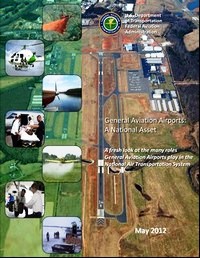Today, the Federal Aviation Administration (FAA) released a study called General Aviation Airports: A National Asset. The FAA conducted the 18-month study to capture the many diverse functions of general aviation (GA) airports. As a result, the general public will have a better understanding of GA airports in the community and within the national air transportation system.

Over the last century, GA airports have evolved from unpaved landing strips to aviation hubs. This in-depth analysis highlights the pivotal role GA airports play in our society, economy, and the entire aviation system. The FAA has conducted previous commercial service airport studies, and now has analyzed both aviation segments with the completion of this GA study.
This strategic tool will help the FAA, state aeronautical agencies, and airport sponsors make planning decisions. The FAA worked with aviation-industry stakeholders including state aeronautical agencies, aviation associations, aviation user groups, airport directors, airport authorities, airport planners, academia, other federal agencies, and local councils of government.

GA airports can serve many different functions and advance the public interest, ensuring that Americans nationwide have access to medical flights, search and rescue, disaster relief, aerial firefighting, law enforcement, community access, commercial and industrial activity, flight instruction, and air cargo. The study also aligns the 2,455 GA airports based on their existing activity levels - national, regional, local, and basic.
The categories reflect the current aviation activity at the airport, such as the number and type of based aircraft, number of passenger boardings, and the type of flights.
- national airports give communities access to national and international markets
- regional airports connect communities to statewide and interstate markets
- local airports provide access to intrastate and interstate markets
- basic airports link communities with the national airport system and support general aviation activities
The FAA plans to further study some GA airports to better understand their role. The FAA will begin working in the fall of 2012 with airport sponsors and state aeronautic divisions to identify the activities these 497 airports support, and how they serve the public interest.
The study does not affect an airport sponsors' eligibility to receive federal funding, and does not remove any airports from the federal five-year planning document called the National Plan of Integrated Airport Systems.
The FAA will incorporate findings of the study into existing GA airport guidance. The United States has the largest and most diverse network of airports in the world and general aviation is a critical component. GA airports do more than relieve congestion at other airports, and in 2009 contributed $38.8 billion to the economy. -FAA.gov- http://www.faa.gov/airports/planning_capacity/ga_study/